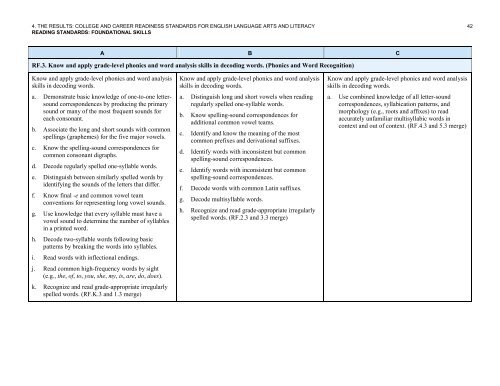CCRStandardsAdultEd
Create successful ePaper yourself
Turn your PDF publications into a flip-book with our unique Google optimized e-Paper software.
4. THE RESULTS: COLLEGE AND CAREER READINESS STANDARDS FOR ENGLISH LANGUAGE ARTS AND LITERACY 42<br />
READING STANDARDS: FOUNDATIONAL SKILLS<br />
A B C<br />
RF.3. Know and apply grade-level phonics and word analysis skills in decoding words. (Phonics and Word Recognition)<br />
Know and apply grade-level phonics and word analysis<br />
skills in decoding words.<br />
a. Demonstrate basic knowledge of one-to-one lettersound<br />
correspondences by producing the primary<br />
sound or many of the most frequent sounds for<br />
each consonant.<br />
b. Associate the long and short sounds with common<br />
spellings (graphemes) for the five major vowels.<br />
c. Know the spelling-sound correspondences for<br />
common consonant digraphs.<br />
d. Decode regularly spelled one-syllable words.<br />
e. Distinguish between similarly spelled words by<br />
identifying the sounds of the letters that differ.<br />
f. Know final -e and common vowel team<br />
conventions for representing long vowel sounds.<br />
g. Use knowledge that every syllable must have a<br />
vowel sound to determine the number of syllables<br />
in a printed word.<br />
h. Decode two-syllable words following basic<br />
patterns by breaking the words into syllables.<br />
i. Read words with inflectional endings.<br />
j. Read common high-frequency words by sight<br />
(e.g., the, of, to, you, she, my, is, are, do, does).<br />
k. Recognize and read grade-appropriate irregularly<br />
spelled words. (RF.K.3 and 1.3 merge)<br />
Know and apply grade-level phonics and word analysis<br />
skills in decoding words.<br />
a. Distinguish long and short vowels when reading<br />
regularly spelled one-syllable words.<br />
b. Know spelling-sound correspondences for<br />
additional common vowel teams.<br />
c. Identify and know the meaning of the most<br />
common prefixes and derivational suffixes.<br />
d. Identify words with inconsistent but common<br />
spelling-sound correspondences.<br />
e. Identify words with inconsistent but common<br />
spelling-sound correspondences.<br />
f. Decode words with common Latin suffixes.<br />
g. Decode multisyllable words.<br />
h. Recognize and read grade-appropriate irregularly<br />
spelled words. (RF.2.3 and 3.3 merge)<br />
Know and apply grade-level phonics and word analysis<br />
skills in decoding words.<br />
a. Use combined knowledge of all letter-sound<br />
correspondences, syllabication patterns, and<br />
morphology (e.g., roots and affixes) to read<br />
accurately unfamiliar multisyllabic words in<br />
context and out of context. (RF.4.3 and 5.3 merge)


